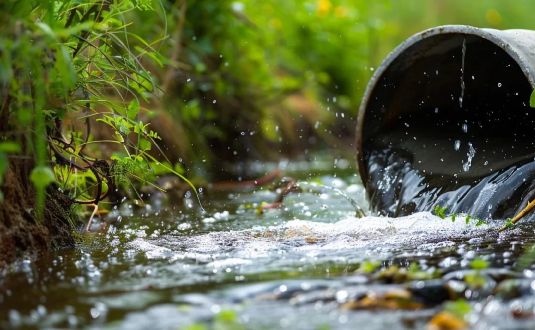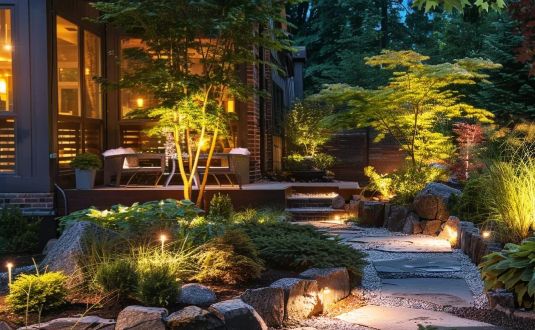Providing Best Services in Huntsville, AL
Providing Best Landscaping Services in Huntsville, AL

.webp)

.webp)
Landscape Edging Types?
The best landscape edging for a garden is one that creates a clean boundary, prevents soil erosion, and keeps mulch from scattering. It also helps in stopping grass from invading flower beds. Materials like steel, aluminium, and concrete offer durability, while rubber and plastic provide cost-effective solutions.
A National Association of Landscape Professionals report states that well-maintained gardens can increase home value by up to 12%. Lawn edging ideas that define spaces neatly make properties more visually appealing and easier to maintain.
For a complete landscape transformation, integrating professional landscaping installation can help create a cohesive and well-structured outdoor space.
What are the Best Lawn Edging Ideas for a Clean Finish?
The best lawn edging ideas for a clean finish include stone, brick, metal, and plastic barriers. Each material has specific advantages based on durability, aesthetics, and cost. Brick provides a classic, long-lasting border that withstands harsh weather. Stone blends naturally with garden spaces, offering a sturdy and refined look. Metal strips add a sleek modern touch while preventing grass from creeping into unwanted areas. For those needing flexibility, plastic edging works well for curved layouts.
A University of Florida study found that metal and stone edging reduce lawn maintenance by up to 30%. Those looking to create durable walkways and structured outdoor spaces may find hardscaping services a perfect complement to their edging choices.
Which Garden Border Edging Material is the Most Durable?
The most durable garden border edging materials are stone, concrete, and metal, which maintain their structure for years despite exposure to weather conditions. Stone and concrete last over five decades with little maintenance, making them ideal for long-term solutions. Metal, particularly steel and aluminium, remains sturdy for decades but requires occasional rust protection. Wood and plastic, while affordable, degrade faster and may need replacing within a decade.
A Royal Horticultural Society report found that concrete and stone edging can extend landscape lifespan by up to 60%. If unstable soil conditions affect the edging, soil amendment and repair can improve foundation strength for longer-lasting installations.
How to Install Best Landscape Edging for Long-Lasting Results
The best way to install landscape edging is by properly preparing the ground, securing the material, and maintaining alignment to prevent shifting. A trench of 4–6 inches deep provides a stable base, while securing materials with stakes or mortar enhances durability. For curved designs, flexible materials like rubber or plastic work best.
According to landscaping professionals, properly installed metal and stone edging can last over 20 years with minimal maintenance. In areas prone to standing water and soil erosion, combining edging with drainage solutions helps prevent shifting and structural damage over time.
What is the Most Cost-Effective Lawn Edging Option?
The most cost-effective lawn edging option is plastic or rubber, as these provide affordability and flexibility. However, metal and stone offer better long-term value due to their durability.
Plastic costs £1–£3 per foot and lasts up to seven years, making it a good choice for temporary solutions. Rubber is slightly more expensive but lasts longer, averaging £2–£5 per foot with a lifespan of around a decade. Steel and aluminium range between £5–£15 per foot, with lifespans exceeding 20 years. Concrete and stone, though pricier at £10–£40 per foot, offer over 50 years of durability with minimal maintenance.
A Homeowners Association survey found that investing in high-quality edging can reduce yearly garden maintenance costs by up to 25%. For those planning a full outdoor redesign, incorporating landscape design services can help blend edging seamlessly with other garden elements.
What are cheap flower bed edging and patio edging ideas?
Flower bed edging cheap options include black poly plastic, wood stakes, or trench lines. Rubber roll edging starts at $2 per foot and bends around curves. Brick leftovers make low-cost patio edging ideas. Gravel bands with steel strips give clean patio edges under $5 per foot. For DIY savings, reuse recycled bricks or timber cut-offs as natural edging barriers.
Final Thoughts on Best Landscape Edging Choices
The best landscape edging for long-term use is stone, concrete, or metal, as these materials last 20 to 50+ years with minimal maintenance. While plastic and rubber are cost-effective, they require replacement every 5–10 years.
A landscape industry report found that 80% of homeowners prefer permanent edging solutions like stone or metal due to their long lifespan. The right choice depends on budget, garden design, and long-term goals.
What is the best landscape edging for homeowners?
The best landscape edging is stone, steel, or concrete for strength and long use. Other top picks include aluminium and composite rubber for curves. Best landscaping edging materials hold shape, block grass, and resist moisture. Garden edging best suited for long-term plans includes precast concrete. For sharp edges and minimal shift, metal landscape edging best fits clean-lined designs. Use best landscaping edgers with straight blades and anchoring spikes for accuracy. Best lawn edging for simple installs includes interlocking stone borders.
Frequently Asked Questions
What is the Best Low-Maintenance Landscape Edging?
Concrete and metal last for decades with little upkeep.
How Deep Should Landscape Edging Be Installed?
A depth of 4–6 inches prevents shifting and adds stability.
Does Landscape Edging Help with Drainage?
Yes, it directs water flow and reduces soil erosion.
Should I hire professional edging services?
Professional edging creates cleaner lines and longer-lasting borders than DIY setups. Experts use tools that press edging deep into compacted soil. A good edging review notes depth control, weather resistance, and edge stability. Pros handle curves and mixed terrain better than standard kits. Request edging services when installing large yards, irregular patios, or sloped flower beds.
Which Landscape Edging Works Best for Curves?
Plastic, rubber, and flexible metal adapt easily to curved designs.
What are popular edging designs for gardens?
Edging designs for gardens include trench, raised, and flush border styles. Curved designs use flexible metal or rubber for fluid paths. Straight-line types suit modern gardens with pavers or concrete. Types of landscape edging fall into 3 categories: natural cut lines, inserted barriers, or built raised beds. Use gravel trims or steel borders for garden edges that prevent soil creep and water washout.
How Much Does Professional Installation Cost?
Prices range from £5 to £50 per foot, depending on material and complexity.
Where can I buy landscape edgers?
Landscape edgers Home Depot offers include steel, plastic, and composite kits. Buyers find edging in-store and online under brands like Vigoro and Dimex. Home Depot sells bulk landscape edgers in straight lengths or flexible rolls. Most listings show per-foot prices and installation ratings. Check for edging reviews, return policies, and project guides under each product description.
Stay Connected and Inspired
Get the latest landscaping tips, seasonal care guides, and exclusive offers delivered straight to your inbox. Don’t miss out on expert advice and ideas to transform your outdoor spaces.
Sign Up for Our Newsletter Today!


Your Next Idea Awaits
Stay inspired with our latest landscaping tips and trends.
.webp)
.webp)

.webp)
.webp)
.webp)
.webp)
.webp)

.webp)








.webp)
.webp)





